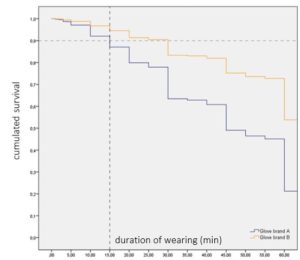What type of glove should we choose?
There are so many type of gloves; powdered and powder free, latex, nitrile, etc. What should we consider when selecting the proper type of glove?
One thing is sure, we should not use powdered gloves, as FDA banned the use of powdered examination and surgical gloves beginning of January, 2017.
The use of latex gloves emerged about 30 years ago, due to the spread of HIV. After that, more and more healthcare worker (HCW) developed allergy to latex. Because of the risk of latex allergy, during the last decade, latex-free gloves became popular [1].
Hübner et al. 2013 examined 1500 pairs of examination gloves, previously used in an ICU. 10.3 % of gloves were perforated, mostly at thumb (24%), palm (19%), wrist (18%) and index finger (17%). Brand new gloves were almost perforation free (0/100 in case of nitrile, 1/100 in case of latex gloves). In this study, the nitrile gloves (NitraTex®, Ansell) had less perforation than latex gloves (PehaSoft®, Hartmann), 7% and 14%, respectively [2].
Bardorf et al. 2016 compared 9 different examination gloves; 4 nitrile, 3 latex and 2 neoprene. After creating a 0.6 mm artificial perforation, the passage of the bacterial suspension was measured during movements. They found a 10-fold higher bacterial passage in the case of nitrile and neoprene gloves. Latex gloves had superior barrier effect against bacterial transmigration in case of micro perforation. They concluded that increased elasticity negatively correlate with bacterial passage. Higher elasticity may allow the re-closure of the perforations [1].
Hübner et al. 2013 also found that the number of micro perforations increased with the duration of wearing, so there is a need for a time limit in recommendations. They suggest 15 minutes, after that time the gloves should change even without other indication (see Figure 1.) [2].

Figure 1.: Gloves “survival”. Brand A is PehaSoft, brand B is NitraTex. Source: Hübner et al. 2013
In our previous post we mentioned that applying handrub on gloved hands become more and more accepted. In that case, glove compatibility with alcohol-based handrubs (ABHR) is also a question.
Gao et al. 2016 examined two different ABHR on 13 brands of gloves. The two ABHR were GOJO (70% ethanol) and Steris (63% isopropanol). Tensile strength decreased with ABHR application, and the ethanol-based product resulted smaller change, than the isopropanol-based. The effect was stronger in the case of nitrile gloves. In conclusion, latex gloves with ethanol seemed to be the better pair of products. Gloves became sticky after 3-4 application of the isopropanol-based ABHR [3].
In a recent study, Scheithauer et al 2016 tested different ABHR/glove combinations. They found that one combination (Sterilium, mixture of propan-1-ol and propan-2-ol and Latex Med Comfort glove) disinfecting efficacy did not reach satisfactory level. They drew attention that – as in this case happened – some products can be incompatible [4].
Overall, they concluded that disinfecting efficacy depend on the material, and nitrile gloves perform better than latex. This finding is in line with the recommendation of the German Aktion Saubere Hände (Clean Hands Action) that allows decontamination of gloved hand only in the case of nitrile glove [4].
Conclusion:
Using gloves is a must. Many people have allergy to latex, they must use latex-free gloves. Both nitrile and latex gloves have advantages. If decontamination of gloved hands is accepted by the institution’s policy, then glove compatibility to the routinely used ABHR still should be tested. Do not use powdered gloves, as it banned by the FDA.
Read our previous post on when to wear gloves, and what do ABHR contain.